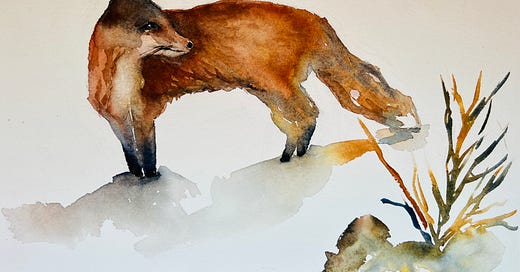In this tutorial, we’ll be painting a fox in a serene winter landscape using watercolor. This piece captures the quiet, watchful nature of a fox in the snow, blending warm and cool tones to create contrast and depth.
Materials you’ll need:
Watercolor paper (cold press, 140 lb recommended)
Watercolor paints (burnt sienna, raw umber, Payne’s gray, ultramarine blue, and yellow ochre)
A medium round brush and a fine detail brush
A palette for mixing colors
A cup of clean water
A paper towel
Step 1: Sketching the Fox
Begin with a light pencil sketch to outline the fox’s body, focusing on its posture and proportions. Keep the lines minimal, as watercolor will define the details later. Lightly indicate the background elements, such as the snowy ground and distant trees.
Drawing Tips and Tricks:
Sketch a circle in the middle of the page for the fox’s head.
Add 3 egg-shaped ovals to the head for the ears and muzzle.
Overlap the bottom right of the head with a slightly larger circle for the neck
Sketch out a much larger oval to represent the fox’s body.
Connect a set of elongated ovals to represent the front legs and feet
Follow a similar process with 4 ovals for the rear legs and feet
Draw the tail out of a long, nearly banana-shaped oval
Refine the fox's body by drawing over your original shapes and add facial features.
Once you have this basic sketch continue refining and adjusting it until you receive your desired result. Draw lightly!
Step 2: Laying the First Wash
Start with a wet-on-wet technique for the background. Using a diluted mix of ultramarine blue and Payne’s gray, gently brush in the upper background to suggest a cold winter sky. Let the colors softly bleed into each other for a misty effect.
I kept my snow mostly white to preserve the brightness of the scene. You can use a very light wash of blue and gray to depict shadows if you wish.
Step 3: Building the Fox’s Form
Using burnt sienna and raw umber, begin painting the base layer of the fox with a both a wet-on wet and wet-on-dry technique. Leave some lighter areas around the chest and face to indicate the natural highlights of its fur.
Once the first layer dries, add more depth by layering in darker tones along the legs, back, and tail using a mix of burnt sienna and Payne’s gray. Use a fine brush for details around the face and ears.
Step 4: Adding Shadows and Depth
To ground the fox in its environment, paint soft shadows beneath its feet using a diluted mix of blue and gray. Let the colors blend naturally into the snowy landscape.
For added realism, enhance the tail with a few fine strokes of darker brown and gray to create the illusion of thick fur.
Step 5: Finishing Touches
Use a fine brush to add small details like whiskers, fur texture, and a slight reflection in the fox’s eyes. Add small branches and tufts of dried grass using yellow ochre and brown for contrast against the snow.
Once everything is dry, step back and make any final adjustments. Sometimes the smallest touches such as deepening the eyes or softening edges bring the painting to life.
Final Thoughts
This painting is all about capturing the quiet solitude of winter and the keen awareness of the fox in its environment. Let the watercolor work its magic, allowing the pigments to flow and create soft, organic textures.
**
Journal Prompts for Reflection
1. The Watchful Fox
Foxes are often symbols of wisdom, adaptability, and quiet observation. Reflect on a time in your life when you had to pause, observe, and make a thoughtful decision. What did you learn from that experience?
2. Winter’s Stillness
This painting captures the hush of winter. Write about a moment when you felt deeply connected to nature in the quiet of the colder months. What emotions did it bring up for you?
3. Movement and Stillness
A fox is both swift and still, blending into its environment yet ready to act. How do you balance moments of stillness and action in your own life?
4. The Colors of Winter
Though winter can seem monochrome, it holds many subtle colors. What colors and textures define winter for you? How do they make you feel?
5. Adapting Like a Fox
Foxes survive and thrive in many different landscapes. How have you adapted to changes in your life recently? What has been challenging, and what has been rewarding?
Thank you for being here! Happy painting and journaling!
XXX Char
PS: I had a BIG splotch of blue/gray from the trees and sky run into the foxes ear and head… I sort of like how it turned out, though! The video didn’t quite capture all of the tones and colors, but I’m glad the final picture did!
If you would like to post your work in the chat (and I hope you do!) it’s open to everyone. Let’s comment and learn from others!
















Share this post